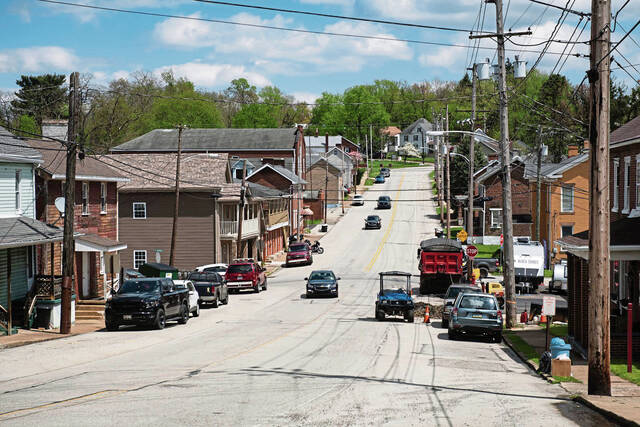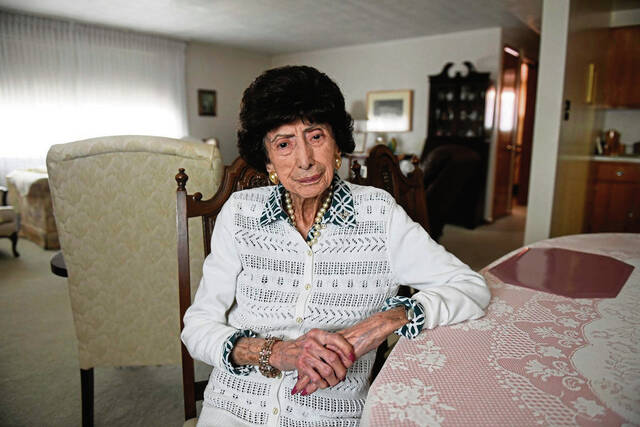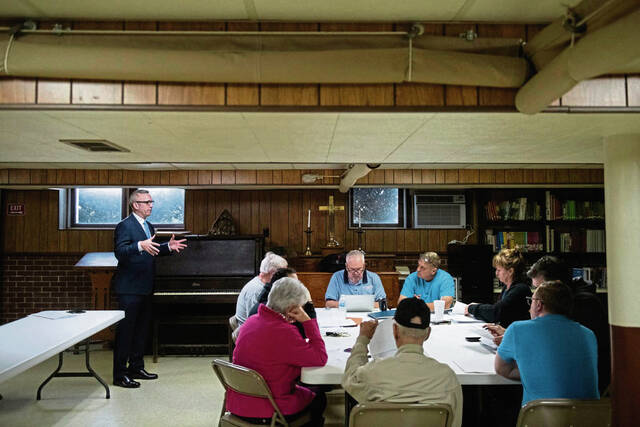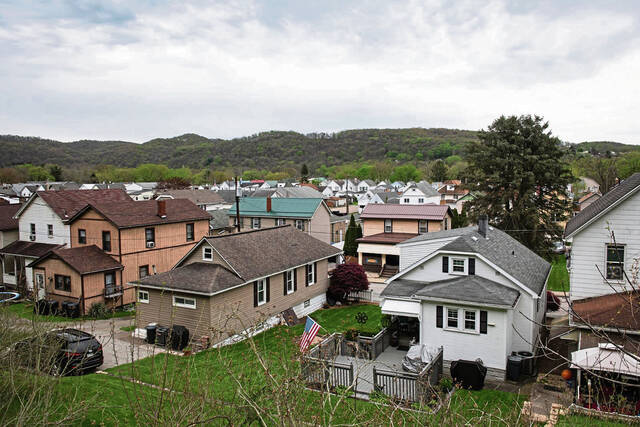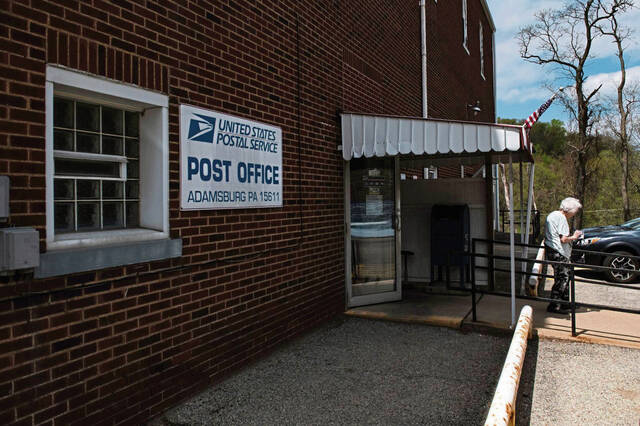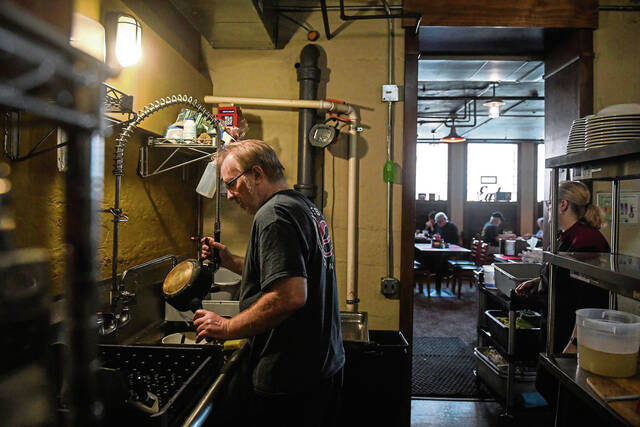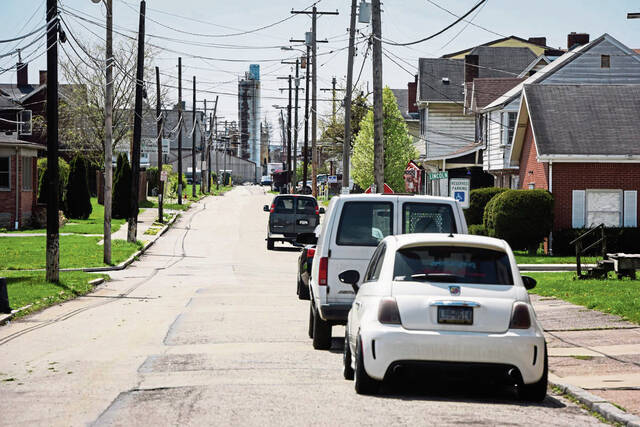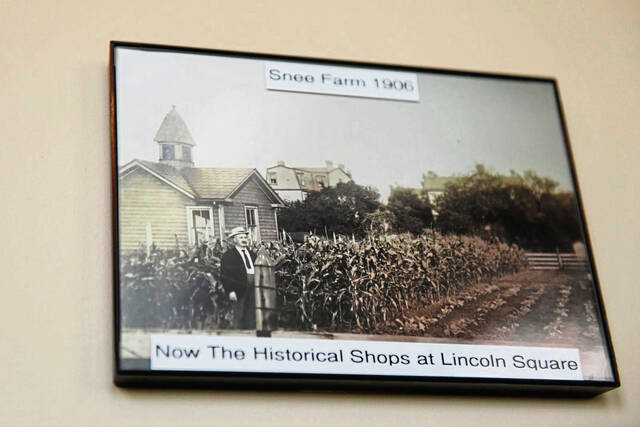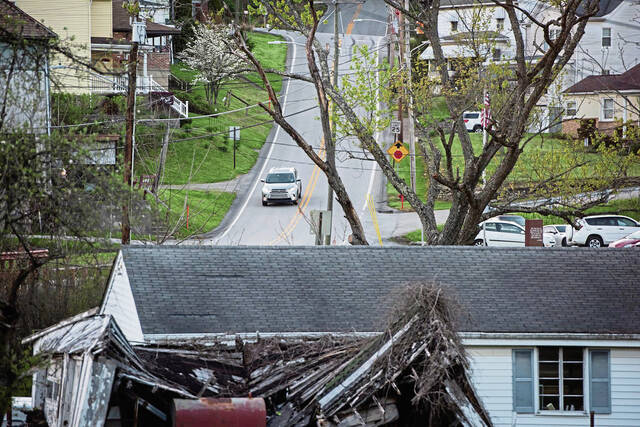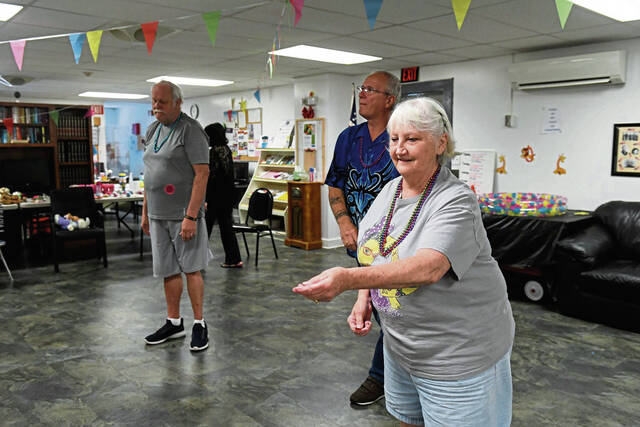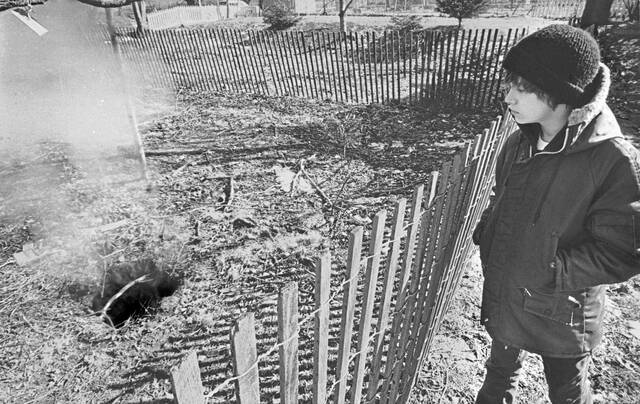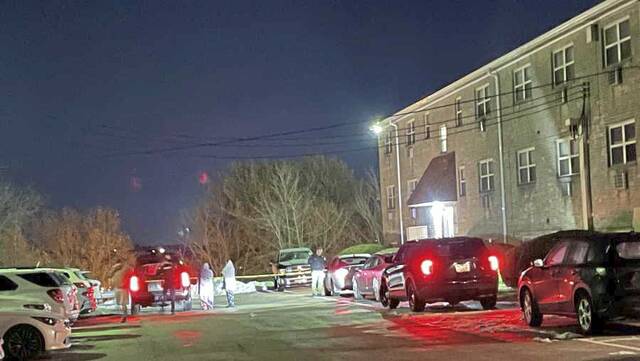Bob Davis spent only seven years of his childhood in Adamsburg before his family moved to Greensburg in 1966, but the borough made an impression.
Davis lived in an old farm house along Main Street. He fondly recalls a bustling town filled with several businesses. There was a service station with one gas pump, a hotel and a tavern. A general store carried basics such as bread and milk, and the popular The Village Inn restaurant served homestyle meals.
“It’s always been close,” said Davis, 72, of Greensburg. “People have helped each other out, and that’s the way it should be.”
Adamsburg today is the second-smallest municipality in Westmoreland County as populations there and elsewhere have continued to decline, leaving local leaders to grapple with the impacts of a dwindling community. Shrinking populations is a problem felt across the state, with almost 800 municipalities — nearly one-third of the 2,560 in all — having fewer than 1,000 residents, according to data from the Pennsylvania Department of Community and Economic Development.
As communities continue to work through issues like a lower tax base and aging populations, several municipalities have had to look into options such as merging with surrounding communities or regionalizing services like police and fire coverage.
But with no clear end in sight to population declines, the fate of some communities could be in jeopardy.
“What’s going on is there’s a lower birth rate, a higher death rate, young people leave and nobody comes in,” said Robert Strauss, professor of economics and public policy at Carnegie Mellon University. “It’s a four-variable process, and the difficulty of a small community in trying to maintain base service levels — think of it as fire, police, water, sewer — are very substantial because you’re losing your ratepayers and then … a lot of the people who remain are poor elderly.”
Struggling municipalities
Over the years, communities have ceased to exist for various reasons.
Residents of Cokeville in Derry Township were forced to move in the early 1950s because of the construction of the Conemaugh Dam. Most Centralia residents in Columbia County had to leave after a mine fire started burning beneath the town in 1962. Millions of dollars were spent in 1983 on an emergency relocation program to move some residents endangered by the fire, which is still burning. The borough technically still has five residents, making it the smallest municipality in Pennsylvania.
But the gradual decline of populations paints a different picture for Pennsylvania communities.
According to Strauss, the degradation of a municipality is a slow process signified by unpaid bills. Contributions to things like the fire service will stop. Borough staff will go from full time to part time, and officials will stop paying for a solicitor’s services.
“What you’re asking is, when do they go out of business? What does it mean? And going out of business means nobody’s running for office, there’s no borough council, there’s no mayor, there’s no manager of public works and increasingly people who are left in these little towns are responsible for their own water and sewer,” Strauss said. “So what you’re talking about, really, is something called municipal bankruptcy.”
In Pennsylvania, municipalities deemed financially distressed by the state are required to go through the Act 47 program.
The program — which was previously implemented in Braddock, Clairton, Duquesne, Pittsburgh and Rankin — provides tools and financial assistance to local governments to help them formulate and implement a recovery plan, said Rick Vilello, deputy secretary for community affairs and development at the state’s Department of Community and Economic Development.
Although being financially distressed does not have direct ties to population, “a diminished population is a common symptom in distressed communities,” Vilello noted.
According to Vilello, if a municipality were to continue to economically deteriorate after entering the Act 47 program, state officials would set forth the procedure for disincorporation of the municipality based on several conditions.
Those conditions — which are related to a deteriorated economy and collapsed tax base, and failed efforts to revitalize or merge with a surrounding community — are used to determine the viability of a municipality.
At this point, no municipality in the Act 47 program has been disincorporated.
“The most extreme thing a municipality can do is disincorporate,” Strauss said. “But they have to still do that with the approval of the courts, and we haven’t seen that yet. So what you see is communities not balancing their books, not filing financial reports, not having elected officials in all the various row offices and the quality of services declining.
“That’s not a very pretty picture.”
Merger option
Adamsburg, named after the country’s sixth president, John Quincy Adams, was first laid out as a village in 1803, acting as a stagecoach stop between Pittsburgh and Ligonier. Over the years, it grew, becoming a hub of activity featuring an active business district, industry and several hotels, one of which was located at the current RV Leaders & Camping Outlet.
But it also took hits. The Pennsylvania Railroad in 1852 bypassed the borough, benefiting nearby towns of Irwin, Manor and Jeannette. By 1930, the Lincoln Highway, which ran through the center of town, was bypassed by the construction of Route 30, which took traffic past Adamsburg. That led to a decline of the busy commercial center.
Adamsburg’s population peaked at 300 people in 1930. It declined to 142 in the 2020 census.
“We’re a residential area that became an off-ramp for Route 30,” said Councilman Bill Lasko, 71.
Related:
• Ghost towns dot Western Pa., Pittsburgh landscape and history
Businesses such as Kenny Ross Ford are located in the borough, but there is no longer a restaurant, gas station or community store. The busiest building is the post office, where a bell on the door jingles with each customer through the door.
With no maintenance department to provide services in the roughly quarter-square-mile borough, unpaid council members — the majority of whom are in their early 70s to late 80s — are tasked with clearing roadkill or filling in small potholes with bags of asphalt purchased from Home Depot.
“Everybody does their part to try to keep things moving,” said Councilman Stan Karaica, 73. “When we see a problem, we try to address it.”
The seven-person council plus the mayor are tasked with negotiating garbage services. They hire companies to complete large projects and work with Senate Majority Leader Kim Ward, R-Hempfield, when needed. Officials also are working to secure grants to help cover costs of future road projects.
Over the years, Adamsburg has turned to a partnership with Hempfield, which helps the borough maintain roads. In turn, Adamsburg allows Hempfield to store salt at the borough building. The Adamsburg Volunteer Fire Company also falls under the township’s department.
Given the partnership, conversations had taken place regarding a possible merger, Mayor Paul Wolfgang said. Those conversations ultimately fell through.
Across the state, the option has not been popular, with only 16 mergers taking place since 1978, according to data from the DCED.
Of mergers that have taken place, none has occurred in Allegheny or Westmoreland counties. A few have taken place across the region. In 1992, Indiana County municipalities of Jacksonville Borough and Black Lick Township merged. By 2008, the Washington County municipalities of West Alexander Borough and Donegal Township also merged.
While the last merger took place in 2016 in Berks County, several conversations have taken place across the region, most notably Pittsburgh’s desire to acquire Wilkinsburg. That proposed merger fell through, along with one proposed this year between West Leechburg and Allegheny Township.
In Adamsburg, few council members expressed interest in revisiting merger talks.
“It could be good. It could be not so good,” Karaica said. “It just depends on where you go with it. Eventually, we’re all going to be gone. Who knows what’s going to happen because we’re in a hot spot right here. Look at the development around here.”
Karaica, like most of the council members, said he would like things to remain as they are.
He said he is the “old school, laid back, just leave” things as they are kind of person.
“I like sitting on the front porch, looking out and seeing woods, seeing the deer, seeing the squirrels running around,” Karaica said. “I don’t want to see house on top of house on top of house with condos everywhere.”
Working together
For 71 years, Louise Biddle has called West Elizabeth home, a fact she expresses with a hint of pride in her voice.
Biddle, 98, who serves on borough council, moved to the community in 1951 after marrying her late husband. At the time, West Elizabeth was a bustling town built off the coal and boating industries. It was filled with grocery stores, a bank, a bakery, funeral homes, service stations and more.
A beach along the Monongahela River just outside of town was a popular spot in the early 1950s.
“This used to be a thriving town,” Biddle said.
Like Rust Belt towns throughout Southwestern Pennsylvania, however, West Elizabeth was largely impacted by the decline of the steel industry.
Today, there are no grocery stores or funeral homes. Like Adamsburg, homes once owned by families were converted into rentals. Pockets of mobile homes are sporadically placed throughout neighborhoods, and big rigs and dump trucks roll from various industries located in and around the borough.
The 2020 census found that 403 people call the borough home, a decrease from the 1,297 people who lived in West Elizabeth in 1940.
In recognition of declining populations, borough officials have largely turned to regionalizing police and fire services. According to council President Lew Miller, West Elizabeth is policed by Elizabeth Borough, and both boroughs are in the process of combining their fire departments.
In addition, West Elizabeth is a member of the Steel Rivers Council of Governments, or COG, a nonprofit that supports 19 Mon Valley communities.
“For municipalities that are smaller, have a lower tax base, have less capacity, COGs are a place where they can work with other municipalities to share and expand their capacity in that way,” said An Lewis, executive director of the Steel Rivers Council of Governments.
Now, working to bolster populations in West Elizabeth falls to a plan that focuses on grants and working with other communities involved in the government council.
“If you have good playgrounds and play areas, that’s going to attract (families),” Miller said. “Hopefully, improving the housing … will attract young couples. I think that’s the game plan, but the key here is how do we pull that off? That’s part of our dilemma.”
Revitalization efforts have been made by people outside of local government, including Rob and Perity Timm, owners of West E Diner, located in the basement of the borough’s old school building.
The couple, who live in Jefferson Hills, attend Calvary Chapel South Pittsburgh, located next door to their business.
“We have a connection in that community down there, and we knew a lot of people because we attend the church next door,” Perity Timm said, noting there are several bars scattered throughout town. “It just felt right. The community needed something like that, and we wanted to be a spot in the community where people could come, family-friendly environment, good food, comfortable atmosphere.”
Today, several industries still call the West Elizabeth area home, including Eastman Chemical Resins, which is right outside the borough, and Clairton Coke Works, located up the Monongahela River. The couple, however, agreed that bringing in other industries and jobs would help bolster the borough’s population.
‘Everybody knew everybody’
Katy Tedeski has called East Vandergrift home her entire life. She can easily remember a time when the small Westmoreland County community tucked between Vandergrift and the Kiskiminetas River was a hub of business and neighbors knew each other.
Sitting in the cafeteria of the East Vandergrift Center for Active Adults, Tedeski, 72, recalled that the McKinley Avenue building formerly housed a grocery store. A second grocery store was across the street in what is now the East Vandergrift Lions Club. Candy stores were scattered throughout town.
“We knew all of our neighbors,” Tedeski said. “And a lot of the houses are from generation to generation. Everybody helped everybody, and everybody knew everybody.”
Today, the community is largely made up of homes that are split by train tracks running through the center of town. Few businesses are located along McKinley Avenue. Slovak and Lithuanian ethnic clubs are located within the community, and religious statues are proudly displayed in front of homes. The sound of church bells can be heard throughout.
Because there are limited places to gather, people often meet in front of the post office. About 20 people per day frequent the senior center.
East Vandergrift was founded as the village of Morning Sun in the 1700s. It wasn’t until 1901 that the community was incorporated as the Borough of East Vandergrift, featuring 75 property owners and 700 residents, according to the borough’s website.
East Vandergrift experienced prosperity and continued to grow for several decades, with an ice plant opening in 1911 that produced up to 37 tons of ice daily. A year later, the first sewer line was laid from McKinley Avenue to the river, street lights were installed, and the first post office opened its doors.
By 1930, East Vandergrift reached a peak population of 2,441 people.
That decade, however, the community was struck by tragedy.
Several fires broke out, the first being in 1933 at the schoolhouse, according to the borough’s website. St. Casimir’s church was destroyed by a fire in 1936, months before the devastating St. Patrick’s Day flood that left 15 feet of water on McKinley Avenue and washed several homes down the river.
By 1940, the population dropped to 2,005. It has continued to decline each decade since.
Today, there are 602 residents living in East Vandergrift.
“There were a lot of older people when I first got here 20 years ago, and, of course, they’ve been dying one after the other,” said Michael Sciberras, a retired pastor at the Our Lady, Queen of Peace Parish.
Borough officials have taken steps to regionalize police services, which now are provided by Vandergrift. But they have not had discussions about merging with surrounding communities, said Councilman Jeremy Manners. Instead, he pointed to things like Morning Sun Senior Lofts, an affordable senior-living residence proposed for the former East Vandergrift Elementary School, to help bolster populations.
“It’s a nice, quiet community, it really is,” Sciberras said. “People here feel relatively safe in terms of what’s going on in the country and other places, especially in Pittsburgh.”
Smaller communities
While declining population seemingly paints a grim picture for some communities, several people working with municipalities on a state level stress that smaller communities are not necessarily a bad thing.
It boils down to finances, said Joy Ruff, executive director of the Pittsburgh-based nonprofit Local Government Academy.
“There are a lot of very small communities that have great finances. … It doesn’t necessarily matter the size, either the population or geographically, square miles,” Ruff said. “It’s does the municipality, does that community, have good, educated, qualified leadership that knows how to run (it)?”
One example is Arona in Westmoreland County, where leaders have planned for shrinking populations, said council President Kathy Sikora.
The borough has continued to see its population decrease, with 255 people living in Arona in 2020 compared to its 1910 peak of 683 people, data show.
“We are really, honestly, the smallest of small,” Sikora said, noting that few people run for local office. “Population will continue to decline, and (our) tax base will continue to decline as well, so we are absolutely constantly committed to keeping expenses to a minimum.”
Borough officials, who host council meetings in the basement of St. Mark’s Lutheran Church, also focus their time on building relationships with county officials and applying for grants.
Nostalgia plays a role, but individual identity matters.
As long as it’s financially feasible, Wolfgang of Adamsburg said his borough prefers to remain autonomous as much as possible.
“It may go (the way of mergers) just like everything else,” Wolfgang said. “We’d like to have a police department, but you know the price of things today, and even the price of gasoline alone. We hate to raise taxes, too, because we really don’t have that much to offer. We’re trying our best. So far, we’re keeping our head above water.”


